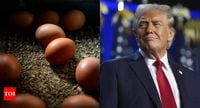In a bold claim during a tariff speech on April 2, 2025, President Donald Trump announced that egg prices had dropped by 59%. He praised Secretary of Agriculture Brooke Rollins for her efforts, stating, “Secretary of Agriculture, great job you did on eggs. Now we have lots of eggs, and they’re much cheaper—down about 59% now—and they’re going down further.” Trump elaborated on the challenges faced just a month and a half prior when egg prices had skyrocketed by 250%, leading to widespread consumer frustration.
According to the U.S. Department of Agriculture (USDA), wholesale egg prices indeed fell to $3.00 per dozen, marking a 9% decline from the previous week. The USDA’s report noted, “The supply situation at grocery outlets has greatly improved in recent weeks and consumers are once again seeing fully stocked shelves and enjoying a range of choices without purchase restrictions.” This marks a significant turnaround in the egg market, which has been grappling with supply issues due to the avian flu outbreak.
The bird flu epidemic, which began in 2022, has wreaked havoc on U.S. poultry farms, resulting in the slaughter of over 145 million birds to control the virus's spread. As of February 2025, the average retail price for eggs was around $5.90 per dozen. The recent price drop is attributed to a slowdown in avian flu cases and reduced demand, allowing suppliers to replenish their stocks.
Stew Leonard, Jr., owner of the Stew Leonard’s grocery store chain, confirmed the trend, stating, “We’re back to low price eggs again. There seems to be plenty of supply.” However, he cautioned that while wholesale prices are decreasing, it may take several weeks for these reductions to be reflected in retail prices. Leonard noted, “I’ve talked to our farmers down in Pennsylvania that have a number of farms with egg-laying hens. They’re repopulating their stock again. Production seems to be back up.”
Despite the positive news, the USDA warned that consumers might not see immediate relief at the checkout. The report indicated, “Only now starting to see shelf prices slowly decline. Demand from egg products manufacturers is mostly light as many have been able to take advantage of a sluggish carton market to build supplies on the spot market, enough to increase production levels to a 3-month high.”
In a bid to stabilize the market, the U.S. government had proposed importing eggs from Poland, Finland, and Denmark. However, these proposals were rejected, prompting officials to turn to South Korea and Turkey as alternative sources. Agriculture Secretary Brooke Rollins announced that hundreds of millions of eggs would be imported to help alleviate the pressure on the U.S. market. This move is expected to provide short-term relief as the country continues to recover from the effects of the avian flu outbreak.
The USDA's report highlighted that national egg prices have seen a decline in various regions. In the New York market, large cartons of eggs saw a nearly 2% decrease, bringing prices down to $3.86 per dozen. In the Midwest, wholesale prices for large white eggs dropped by 32%, now at $3.69 per dozen. California also experienced a decline, with large eggs falling 18.6% to $5.34 per dozen.
Amidst these fluctuations, consumers have faced challenges over the past months, particularly as retailers like Kroger, Trader Joe's, and Costco implemented purchase limits in February due to soaring prices. This phenomenon, often referred to as "egg-flation," has been a source of concern for many households trying to manage their grocery budgets.
In March 2025, the USDA reported a significant decline in bird flu cases, with only 2.1 million reported, a stark contrast to the 12.64 million cases in February and 23.19 million in January. This reduction has contributed to the improved supply situation, allowing prices to stabilize.
While the recent trends in egg prices are encouraging, the USDA cautioned that consumers should remain vigilant. Wholesale price changes can take up to three weeks to be reflected in retail prices. The USDA reiterated, “Consumers are only now starting to see shelf prices slowly decline.”
As the market adjusts to these changes, many are hopeful that the combination of improved supply, reduced demand, and government intervention will lead to a more stable and affordable egg market in the coming months. With Easter approaching, the emphasis on egg availability has never been more critical, and consumers are eager for the prices to reflect the recent improvements.
In summary, while President Trump's claims about the dramatic drop in egg prices may have raised eyebrows, the USDA's reports provide a more nuanced picture of the ongoing recovery in the egg market. With the combined efforts of farmers, retailers, and government officials, there is cautious optimism that the U.S. egg market is on the mend, paving the way for more affordable prices for consumers.





